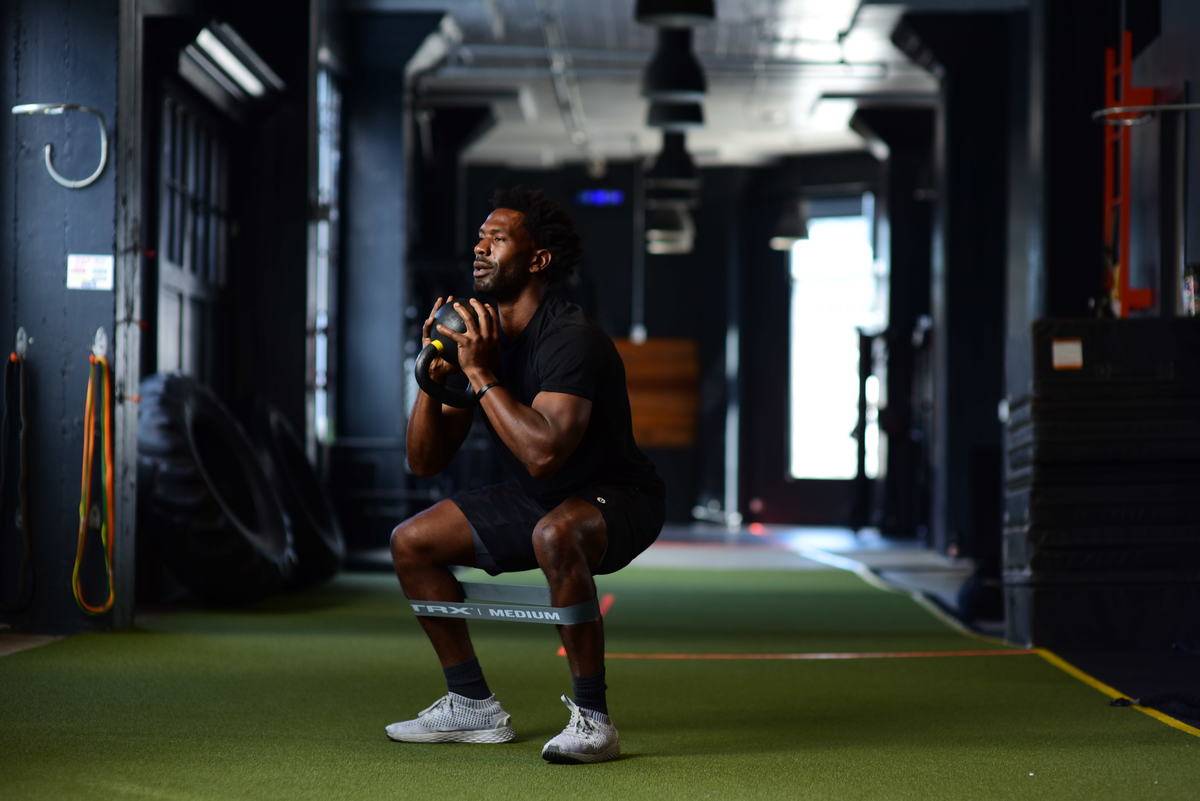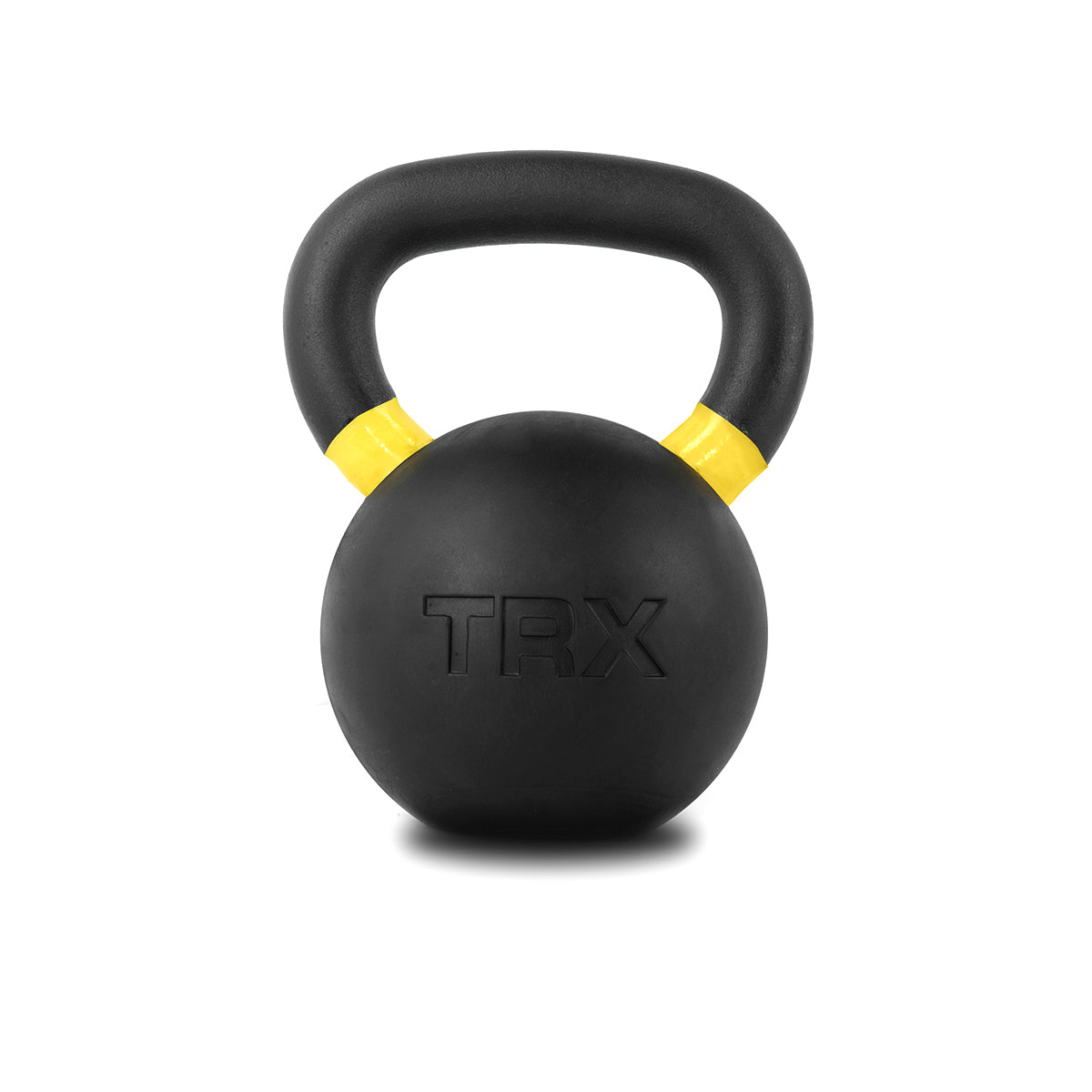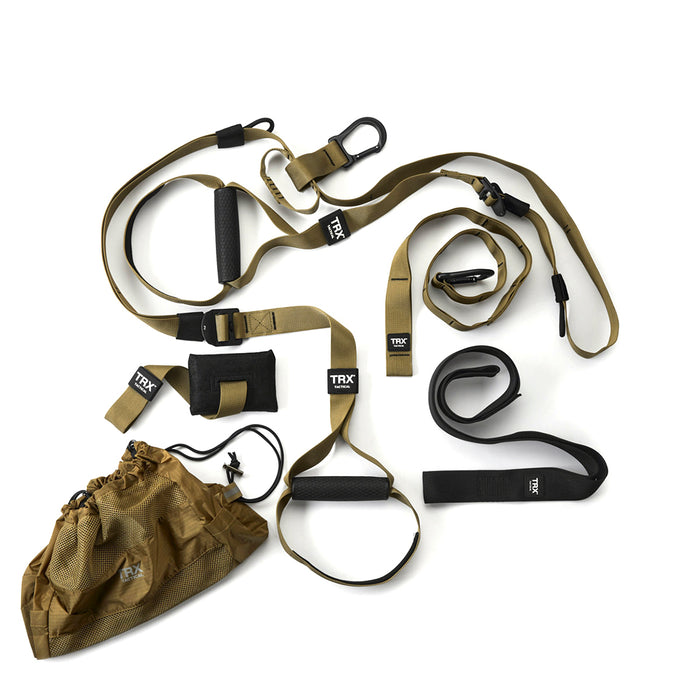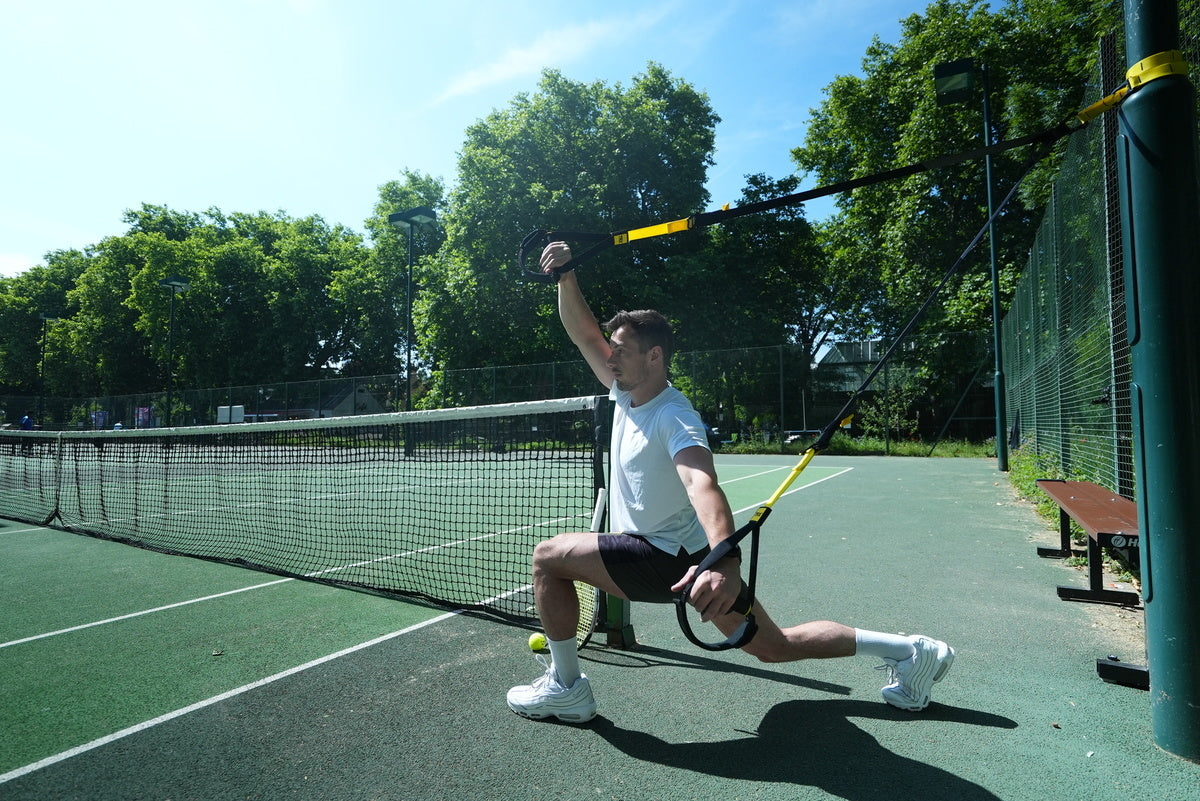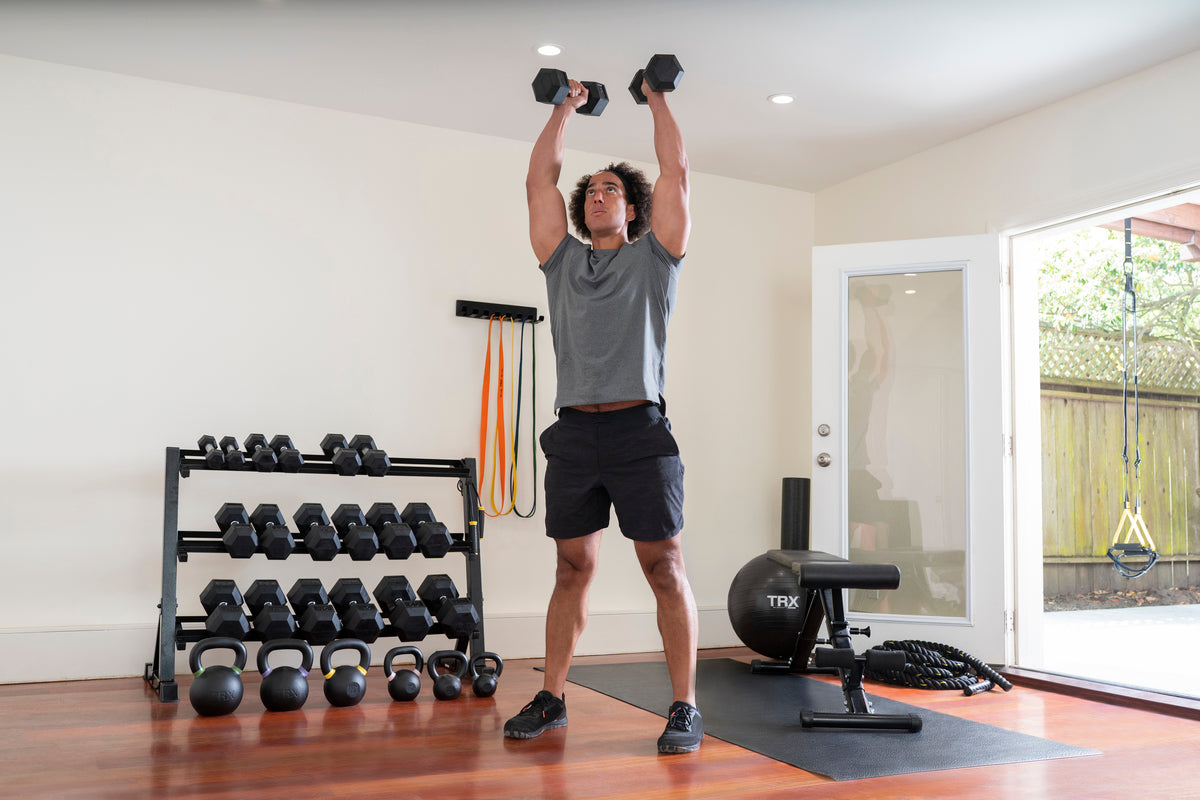Strength training has increasingly become more and more popular each year. More people are taking action in search of the benefits of building muscles, burning more calories, losing body fat, reducing joint pain, managing stress, improving balance, increasing stability, and improving their overall fitness(1)
If you strength train your lower body with kettlebells, you can even further stack the chips in your favor because of the added benefits this training modality provides. The kettlebell's shape and size create an environment that requires more stability and muscle recruitment than with dumbbells or barbells(2). Kettlebells also offer unique movements that are ballistic which means they create higher power output, resulting in superior strength gains when paired with traditional strength training exercises such as deadlifts, squats, and lunges.
Anatomy of Your Legs
The lower body is composed of 6 main groups of muscles; Quads, Glutes, Adductors, Hamstrings, Calf, and Shin. We can also add your hip flexors which are composed of your psoas and Illiacs muscles, but those are deep within the hip and are strengthened along with the other muscles of the leg when performing exercises with proper form. Within each group, there are individual muscles that create specific actions. In this article, we will be focusing on the muscles of the upper leg, as the lower leg muscles gain all the benefits from these exercises, but are not the stars of the show. The calf and shin muscles contribute as secondary movers or stabilizers to the knee and act more on the ankle joint below.
For example, the quads on the front of your thigh cause your knee to extend. Exercises like squats, lunges, or machine leg extensions would target that group. Your glutes are responsible for hip extension which brings your hips forward like when you stand up out of a chair, or when doing deadlifts, hip thrusts, or squats. Your glutes are not only the part you sit on, but also attach to the top of your hips and cause hip abductions This motion is when you move your leg away from the middle of your body, in real life such as brushing leaves or dirt off to the side on the ground with your foot, or kicking your leg back. Exercises such as band/cable abductions, machine abduction, or glute kickbacks strengthen this specific part of the glute muscles.
The adductors are responsible for just the opposite action, they are on the inside of your thighs and bring your legs closer together, such as during a side lunge, deadlift, or machine adduction. The hamstrings, on the backs of your legs, cause the knees to flex or be pulled back such as when you go running, do butt kickers, or as you pull yourself along in a rolling chair in your house or at work or school. Exercises like deadlifts, kettlebell swings, machine hamstring curls, and other variations of this same exercise are great for developing hamstring strength
The Best Kettlebell Exercises for Your Legs
We’ve covered various kettlebell exercises, including a kettlebell tricep workout. Today, we’re going to strengthen your lower body with these 15 kettlebell leg exercises.
Here's what you'll need:
15. Kettlebell Half Kneeling Hip Opener
This mobility exercise aims at stretching out the often tight adductors or inner thighs, as well as the front of the hip(quads and hip flexors) on the opposite side. This combination of stability and mobility is great to start off any lower-body or full-body training session or class.
During the shift into the adductors stretch line your knee up with your outside toes, pause in the stretch and take a breath to increase the effect
Ease into the stretch by rocking into it, breathing, rocking out, and repeating. Give it 3-5 rocks before switching sides, repeating 2 or 3 times on each side with a :30-1:00 break in between.
14. Kettlebell Goblet Swing
This variation of a hinging movement pattern mimics that of the kettlebell swing and is a great activation exercise for the glutes, hamstrings, and core musculature to prepare for the kettlebell swing and other lower body exercises. This move aims to load the hips, legs, and trunk similarly to the kettlebell swing while minimizing the risk of injury and creating an environment for the body to learn how to move with the bell safely and instinctively.
Holding the bell tight, try to pull the kettlebell apart as if ripping open your shirt to show an “S” on your chest as if you were a superhero. This keeps the bell in the right at your chest as you push your hips back and snap them forward, mimicking a kettlebell swing
Work to become proficient in this exercise before moving on to the kettlebell swing to help prevent injury by creating a strong base and understanding of the movement. Doing 2-4 sets of 5-10 reps is a great range to start.
13. Kettlebell Goblet Squat
The squat is a great exercise for lower body strength and endurance and this exercise is a staple in training with kettlebells. This squat variation is accessible to most people, especially if you struggle with using a barbell or holding dumbbells in the same goblet position. Squats target your glutes and quads predominantly but your hamstrings and upper body will also benefit from this squat variation.
The kettlebell offers a more ergonomic grip and the skills produced from holding the bell in place during the movement carry over to the upper body and overall grip strength
During this exercise hold the bell tight while trying to pull the kettlebell apart as if ripping open your shirt to show an “S” on your chest like you were a superhero to keep your chest up during the squat. Drive your knees out and press your toes down hard into the floor as you come up from the bottom of the squat. Begin with 2-4 sets of 10-15 reps.
12. Goblet Get Down to Get Up
This take on the popular Turkish get-up is a less technical variation and provides a minimum effective dose of challenge and provides a great deal of feedback as well. This means it provides a lot of the benefits of the Turkish get-up without the rigid and proper form required for safety. The conditions of this exercise require you to keep the kettlebell in its upright position with the forearms perpendicular to the floor at all times as you move from a standing position to lying flat on the ground, to standing back up.
This exercise forces you to move instinctively with the kettlebell and find ranges of motion within your hips, ankles, and even upper back (thoracic spine) to complete the exercise with proper form. Your quads, glutes, and hamstrings will be involved with this exercise and challenge your body as a whole.
I suggest starting with a modest weight, something you are 100% confident you can get down and get back up with, starting with 2 -5 reps or a running clock of 1:00 for a baseline. Depending on skill level, this can be used as a warm-up, activation exercise before Turkish get-ups, or even a conditioning movement at the end of a session.
11. Kettlebell 2 Handed Deadlift
Mastering the deadlift will develop your glutes and hamstrings, as well as build up the strength to perform more complex and fun kettlebell exercises. The deadlift is the basic foundation of the swing, clean, and snatch exercises, meaning the more proficient the deadlift, the easier it will be to learn more advanced variations.
When you grip the handle of the kettlebell, give it a good squeeze during the entire set. Grip strength is directly correlated with core strength, thus a firm grip can help to keep your core engaged during the movement giving you more stability and strength during the exercise. Shoulder blades should be packed down and back to keep your back flat, preventing rounding. The lower back is not the target muscle, keeping proper posture goes a long way when working with kettlebells and any form of resistance in general.
Squeeze glutes hard through the top of the movement to get all of the benefits of the exercise. Oftentimes I see people relax their glutes at the top, losing the opportunity to create full body tension and stability, which is vital for proper form and strong lifts.
Depending on the goal of the training session deadlifts can be done anywhere in the range of 2-5 sets and 5-10 reps. A good starting point would be 3 sets of 5-8 reps.
10. Kettlebell Single-Arm Deadlift
The single-arm variation of the deadlift works twofold; the single-arm variation does challenge the body from a left and right or lateral perspective. Managing a load on one side of the body requires the core musculature to engage at a higher level or intensity to prevent us from shifting, rotating, or moving in a funky way.
Another reason to add in single-arm deadlifts is to prepare for other more advanced single-arm kettlebell exercises such as the kettlebell clean and kettlebell snatch.
Hips and shoulders should be square forward when picking up and putting the bell down, vs. having your torso rotated; this helps to create better core control and reduce torque on the lower back. I suggest starting with 2-3 sets of 5-8 reps per side.
9. Kettlebell Single Arm Rack Offset Reverse Lunge
Offsetting the kettlebell to the opposite side of the body creates an environment that asks the core to work harder to create stability. Placing the bell in a rack position with the bell on the outside of the body and the bell moving back away from the stable leg creates a lateral and rotational force that the core musculature has to counteract, creating the demand for more stability. Without this action by the core, you would either fall over sideways towards the bell or lose your balance as you step back.
As you step back, keep the knee of the working leg driven out towards your pinky toe. When using a mirror to check form you should be able to see the inseam of your shorts/pants. Squeeze your glutes as you come up from the bottom of the lunge to help take unwanted pressure off your knee. Depending on skill level, you can start in the range of 2-4 sets of 8-12 lunges on each side.
8. Kettlebell Single-Leg Deadlifts
Balance and core stability along with training the hamstrings, glutes, and calve muscles are to be expected with the kettlebell single-leg deadlift. Categorized as a hinging exercise, the single-leg deadlift challenges single-leg stability and flexibility of both legs because of the requirement of the floating leg to stay square with the ground while maintaining tension throughout the entire leg, including the glutes, quads, hamstring, and lower leg musculature.
During the exercise, create tension in your floating leg as it hinges up to parallel with the ground. This action will make it easier to keep balance and not feel as if there is a literal weight hanging off your body. This paired with spreading your toes and sinking into the middle of your standing foot can help to smooth out this challenging lower body exercise. Gripping the KB tight will also create more tension in the core which equals more stability
If needed, start off by providing a stable point to help with balance while working out the form. Over time, take the balance away and challenge yourself without it. Start with 2-3 sets of 6-12 reps on each side.
7. Kettlebell 2 Hand Swing
Primarily targeting the glutes and hamstrings, the kettlebell 2 hand swing is a ballistic type movement that is meant to be fast, and explosive and create tremendous amounts of full body tension and force from your body. This exercise has been shown to mimic the benefits of plyometric training when it comes to power output and recruitment of larger muscles (3). This means getting the benefits of jumping without the wear and tear on joints which can be an issue for people who have injuries or are older and not conditioned for jumping and the impact from it.
Proper form during the lift-off to setting down the weight is the most important part of the kettlebell swing in any variation. Please consult a trained expert or reputable source you trust before attempting this exercise. (Such as the TRX Kettlebells Training Essentials)
When performing properly, you will always start by placing the belly just in front of your toes and then hiking or pulling the bell between your upper thighs, followed by a downward drive of your feet into the ground and simultaneously snap of your hips forward with a squeeze of your glutes, which sends the bell floating somewhere between belly button and shoulder height before it comes back down between the thighs again… As you can tell this is not a beginner exercise and will take practice to master, but it is very achievable once you have the right information and form..
Start with 3-5 sets of 3-5 swings if you are just taking on this exercise. You will want to chain a few reps together that feel good, but not too many together that you begin to have form breakdown.
6. Kettlebell Single Arm Rack Squat
- This squat variation targets the quads and glutes predominantly but having the bell only in one arm also promotes more core stability and creates a challenge within the body to not shift to one side. This can also expose movement compensations, which can be beneficial because you can work on correcting them before they can otherwise lead to injury and time away from training.
- Single arm rack squats are a great exercise to create the necessary skills to move to advanced exercises like kettlebell cleans, and double front rack exercises like squats, lunges, and step-ups.
- Hug the bell in tight to your body with your thumb close to your collarbone, forearm vertical, and head pulled back. Start with 2-4 sets of 8-12 reps per side
5. Kettlebell Front Rack Walking Lunge
This double kettlebell exercise targets primarily the quads but will hit the glutes as secondary muscles. The challenge of this variation is not only the burning sensation of the quads but also having to manage 2 weights held up by your back and core as you move forward. Having already developed the prerequisite strength to carry the load with your upper body, as you move, your chest should remain upright with your back flat and shoulders down.
As you lunge forward your front knee should be in line with your 2nd to last and last toe, this helps to keep the glutes involved and takes some pressure off the knee. Drive up from the bottom of the lunge by pushing off your front leg, squeezing your glutes, and for an added benefit also think about squeezing your inner thighs back together like a pair of scissors closing together. This added mind-to-muscle connection can often improve your form and even allow you to add reps or weight after a set.
Depending on the goal, you can use lunges for strength or endurance. I suggest starting in the middle with 2-3 sets for 8-10 reps on each side. Alternate legs as you go vs. only doing one side at a time.
4. Kettlebell Offset Stance Romanian Deadlift
The Romanian variation of a deadlift focuses on placing constant tension on the hamstrings as well as the glutes. When implementing the offset stance, the added balance of keeping your foot on the ground allows you to use heavier loads for more gains in strength and/or size of the muscles vs. the Single leg variation.
Place 90-95% of your weight on the working leg during the movement, if the difficulty of the set feels the same from start to finish or gets easier, you are putting too much weight on the balance leg. Keeping shoulders back and chest forward during the movement with a strong grip on the handles of the bells.
Start with 2-4 sets at 8-12 reps per side, adjusting for conditioning and load. Start light if you are a beginner to see how you feel. If you predominantly feel this in your lower back, focus more on squeezing your glutes during the movement, and limit how far down you go with the weight, stopping when your hands get to around your knees.
3. Kettlebell Heels Elevated Double Rack Squats
By elevating the heels this movement biases the quads, putting more tension on them than the glutes. Using kettlebells for this movement allows those who may have mobility issues in their shoulders or tight lats that cannot do barbell front squats. Combine this with a more narrow stance and you will feel the quads burning in no time.
Hug the kettlebells tight to the body during the movement, aligning thumbs with the middle of collar bones and forearms vertically. Sit straight down, putting the weight into the middle of your foot, then drive from the middle of your foot on the way up, squeezing your quads hard.
This exercise is great as a longer set, with lighter loads, but can also be done in more medium and short set ranges. I recommend trying 3-4 sets of 12-20 reps.
2. Kettlebell Single Arm Clean
A kettlebell clean is a technically challenging exercise, that should be broken down into steps as you are learning it. Mastering the kettlebell deadlift, kettlebell single arm deadlift, kettlebell 2-handed swing, and finally the 1-handed swing before trying to move to the kettlebell single arm clean. Cleans are a very effective exercise at developing strength, power, and explosiveness and transfer well to overall athleticism such as jumping height and distance (3). All of those characteristics of movement derive from the lower body during a kettlebell clean. This movement, much like the kettlebell swing, should be learned from a trusted coach, trainer or resource to set you up for the best possible success.
During the pull phase while the bell is traveling upward, keep it close to your body like zipping up a jacket. As you catch the kettlebell in the rack position your wrist should be flexed slightly forward or curled in. If the wrist is bent backwards this can cause unwanted pain and potential damage over time. Seek out resources or a coach or classes that can help teach you proper form. Once you've learned the skill, you just have to practice, which can be a full workout in itself, providing a very efficient training experience
1. Turkish Get Up
This exercise is not just a lower body exercise, but I chose to put it on the list because of the great amount of benefits it has and it does require a good amount of lower body strength, flexibility, and stability. It also requires the same of the upper body too. This exercise is a great ‘goal’ exercise, meaning that you can aim to work up to being able to do this exercise with great form and skill. The kettlebell goblet get down to get up mentioned earlier in the is list is a great way to judge if you are ready to tackle this exercise; if you find the aforementioned exercise challenging still, then work on what is challenging about it. If you struggle to keep your chest up right, work core stability and mobility of the thoracic spine. If it's challenging for you to stand back up from the ground, then choosing some of the exercises from this list is a great start. If you cannot sit up then strengthening your abs with kettlebells is the direction to go.
Create tension throughout the body by driving your legs into the ground and squeezing the kettlebell hard before initiating your first movement. Pause in each position to really feel where the stability needs to come from to allow you to move on to the next step. Less is more with this exercise, meaning work to get good at the details of bracing your core, keeping your shoulder blades packed, keeping your eyes on the kettlebell, and breathing during the exercise to stay in control.
I recommend starting out with 2-3 get-ups on each side for 1-3 sets. Start with an empty shoe on top of your fist. The idea behind this is to build up your ability to keep your arm stable and stacked vertically at all times over your shoulders. If you cannot stabilize your shoe, putting a kettlebell up there is likely to not work as well.
Try Our Kettlebell Leg Workout Today
Putting some of the exercises together for an effective lower body day will start to show you how some of the pieces of kettlebell training can come together.
- 1a. Kettlebell Half Kneeling Hip Opener: 3 sets x 10-12 reps per side
- Rest:30 seconds before going to 1b
- 1b. Kettlebell Goblet Swing: 3 sets x 5-8 reps
- Rest 1:00 before starting the next set
- 2. Kettlebell Deadlift: 3-4 sets x 5-10 reps
- Rest 1-2 minutes between sets
- 3a. Kettlebell Single Leg Deadlift: 3 sets of 8-12 reps per side
- Rest:0-:30 between sides, Rest:30-1:00 before going to 3b
- 3b. Kettlebell Single Arm Squat: 3 sets of 8-12 reps per side
- Rest:0-:30 between sides, Rest 1:00-2:00 before starting next set
- 4a. Kettlebell Offset Rack Reverse Lunge: 3-4 sets of 10-12 reps each side
- Rest:0-:30 between sides, Rest 30-1:00 before going to 4a
- 4b. Kettlebell Heels Elevated Rack Squat
- Rest 1:00-2:00 before starting the next set

